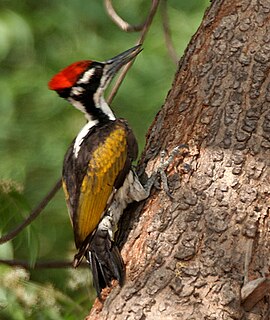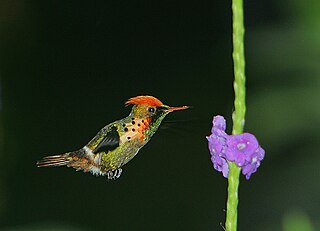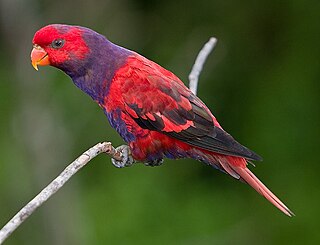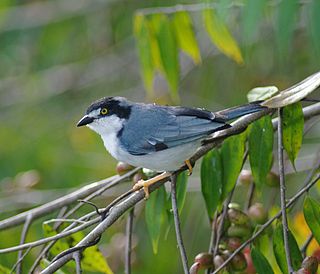
The red-billed blue magpie is a species of bird in the crow family, Corvidae. It is about the same size as the Eurasian magpie, but has a much longer tail, one of the longest of any corvid. It is 65–68 cm (25.5–27 in) long and weighs 196–232 g (6.9–8.2 oz).

The masked lapwing is a large, common and conspicuous bird native to Australia, particularly the northern and eastern parts of the continent, New Zealand and New Guinea. It spends most of its time on the ground searching for food such as insects and worms, and has several distinctive calls. It is common in Australian fields and open land, and is known for its defensive swooping behaviour during the nesting season.

The yellow-wattled lapwing is a lapwing that is endemic to the Indian Subcontinent. It is found mainly on the dry plains of peninsular India and has a sharp call and is capable of fast flight. Although they do not migrate, they are known to make seasonal movements in response to rains. They are dull grey brown with a black cap, yellow legs and a triangular wattle at the base of the beak. Like other lapwings and plovers, they are ground birds and their nest is a mere collection of tiny pebbles within which their well camouflaged eggs are laid. The chicks are nidifugous, leaving the nest shortly after hatching and following their parents to forage for food.

The western plantain-eater, also known as the gray plantain-eater or western gray plantain-eater, is a large member of the turaco family, a group of large arboreal near-passerine birds restricted to Africa.

The white-naped woodpecker is woodpecker which is a widespread but a scarce breeder in the Indian Subcontinent. It is associated with open forest and scrub with some trees. It nests in a tree hole, laying one or two white eggs.

The tufted coquette is a tiny hummingbird that breeds in eastern Venezuela, Trinidad, Guiana, and northern Brazil. It is an uncommon but widespread species, and appears to be a local or seasonal migrant, although its movements are not well understood.

The crowned lapwing, or crowned plover, is a bird of the lapwing subfamily that occurs contiguously from the Red Sea coast of Somalia to southern and southwestern Africa. It is an adaptable and numerous species, with bold and noisy habits. It is related to the more localized black-winged and Senegal lapwings, with which it shares some plumage characteristics.

The Luzon hornbill, sometimes called Luzon tarictic hornbill, is a species of hornbill in the family Bucerotidae. It is endemic to forests on Luzon and nearby islands in the northern Philippines. As is the case with all Philippine tarictic hornbills, it has been considered a subspecies of P. panini.

The violet-necked lory is a species of parrot in the family Psittaculidae. It is endemic to Indonesia, where it is found in the northern Maluku Islands and west Papuan islands. Its natural habitats are tropical moist lowland forests and tropical mangrove forests.

The lilac-tailed parrotlet is a species of parrot in the family Psittacidae. It is found in Colombia, French Guiana, Guyana, Suriname, Trinidad and Tobago, and Venezuela. Its natural habitats are subtropical or tropical moist lowland forest and subtropical or tropical moist montane forest.

The spotted rail is a species of bird in the family Rallidae. It is found in Argentina, Belize, Bolivia, Brazil, Cayman Islands, Chile, Colombia, Costa Rica, Cuba, the Dominican Republic, Ecuador, El Salvador, French Guiana, Guyana, Jamaica, Mexico, Nicaragua, Panama, Paraguay, Peru, Suriname, Trinidad and Tobago, Uruguay, Venezuela, and possibly Honduras. The spotted rail is found in marshland and swamps.

The rufous-throated antbird is a species of bird in the family Thamnophilidae. It is found in Brazil, French Guiana, Guyana, Suriname, and Venezuela. Its natural habitat is subtropical or tropical moist lowland forests.

The helmeted pygmy tyrant is a species of bird in the family Tyrannidae. It is found in Brazil, Colombia, French Guiana, Guyana, Peru, Suriname, and Venezuela. Its natural habitats are subtropical or tropical moist lowland forests and heavily degraded former forest.

The hooded tanager is a species of bird in the tanager family Thraupidae. It is found in Argentina, Bolivia, Brazil, Colombia, French Guiana, Guyana, Paraguay, Peru, and Venezuela. Its natural habitats are subtropical or tropical moist lowland forest, subtropical or tropical mangrove forest, and heavily degraded former forest.

The red-necked woodpecker is a species of bird in the family Picidae. It is found in Bolivia, Brazil, Colombia, Ecuador, French Guiana, Guyana, Peru, Suriname, and Venezuela. Its natural habitats are subtropical or tropical moist lowland forest and subtropical or tropical moist montane forest.

The spot-breasted woodpecker is a species of bird in the family Picidae. It is found in South America in Bolivia, Brazil, Colombia, Ecuador, French Guiana, Peru, Suriname and Venezuela and also in eastern Panama of Central America. Its natural habitats are subtropical or tropical moist lowland forests, subtropical or tropical mangrove forests and heavily degraded former forest.

The olive woodpecker is a species of bird in the woodpecker family Picidae.

The yellow-throated woodpecker is a species of bird in the family Picidae, the woodpeckers, piculets, and wrynecks. It is found in northern and central South America in Brazil and the entire Amazon Basin; also in the Guianas, and Bolivia, Colombia, Ecuador, French Guiana, Guyana, Peru, Suriname and Venezuela. Besides the Amazon Basin, it is found in the southeast basin in the adjoining Tocantins-Araguaia River drainage; on the east at the edge of its range there, it only occurs in the headwaters of the Tocantins, then recontinues at the joining of the Araguaia-Tocantins as it goes to the Atlantic Ocean.

The white-bellied seedsnipe is a species of bird in the Thinocoridae family. It is found in southwestern Argentina and Tierra del Fuego. It is a vagrant to the Falkland Islands, and its Its natural habitats are temperate grassland and swamps.

Edme-Louis Daubenton was a French naturalist.





















